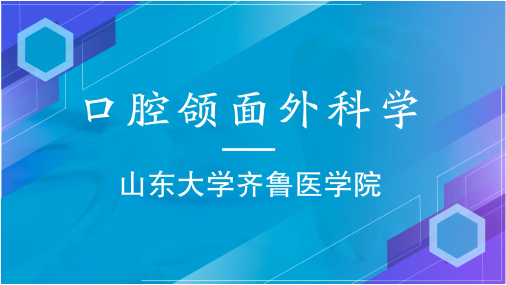
当前课程知识点:Traditional Chinese Medicine > Chapter 5 Etiology and Pathogenesis > Section 1 Etiology of TCM > Etiology of TCM
返回《Traditional Chinese Medicine》慕课在线视频课程列表
返回《Traditional Chinese Medicine》慕课在线视频列表
Hello everyone
For today’s class we’ll study a new chapter
Chapter 5 etiology and pathogenesis of TCM
From TCM view etiology mainly refers to the pathogenic factors
which could induce disease
Pathogenesis usually refers to the whole process of onset
progression and prognosis of disease
First let’s get to know the contents of etiology
There is a close relationship among
etiology pathogenesis and symptoms
Etiology and pathogenesis mainly discuss the causes of disease
and the mechanism of disease’s occurrence
development and evolution
According to TCM
etiology refers to various kinds of factors that cause diseases
such as abnormal climates seven emotions
phlegm retention blood stasis etc
For example we have a patient with the symptoms
like fever cough sneezing running nose and stuffy nose
How do we know what the pathogenic factors are
To answer this question body temperature
blood and/or urine test and image examination
may be applied by the western medical doctor
to find the bacteria or viruses
which induced the disease
In order to understand the etiology
TCM will focus on the symptoms and signs
at the same time
the doctor usually checks the tongue and feel the pulse
for the patient
Then based on all the information collected
by using the diagnostic methods
the TCM doctor will infer the pathogenic factors
which induce the disease
Analysis of symptoms and signs
to deduce the etiology
such method is called syndrome differentiation
to determine disease cause
To be more specific
the etiology is classified into three categories
The six pathogenic factors invading the body from the outside
which are called external pathogenic factors
For example wind
as one of the six external pathogenic factors
invades human body mainly through skin nose or mouth
The seven emotions directly involving the internal organs
which are called internal pathogenic factors
Third the pathological products
such as static blood
can induce disease as a kind of pathogenic factor
Now let’s go through all kinds of pathogenic factors
Under normal circumstances wind cold summer-heat
Dampness dryness fire/heat are called six qi
They are six normal conditions of nature
and are harmless to human body
When excessive or deficient climate occurs
for example too hot
in summer or too warm in winter
and rapid climate changes
the body cannot adapt then disease occurs
On the other hand
when people are too weak to adapt themselves
even to normal climate changes
the six qi will also become
pathogenic factors
to attack and cause disease
Under these circumstances
the six qi are called six pathogenic factors
There are some characteristics for six pathogenic factors
First they invade human body through skin
or from nose or from mouth or both at the same time
Second they have a closely relationship with seasonal changes
For example in spring there may be more wind diseases
summer more heat diseases etc
Third they can invade the body respectively and simultaneously
For example common cold due to wind-cold
diarrhea due to dampness-heat etc
Wind belongs to Yang pathogen
mainly attacks the upper part or the surface of the body
Wind tends to mobile and causes diseases with no fixed place
such as syndrome of
migratory arthralgia
On the other side
wind diseases are unpredictable and attack quickly
such as urticaria
Wind tends to cause vibration
the symptoms like tremor
vertigo convulsions
stiff neck and so on
Wind is the primary pathogen that leads to be complicated by other
pathogenic factors
that is attached by other pathogens
For example cold tends to attached to wind
when attacking body
causing syndrome like wind-cold
Cold belongs to Yin pathogen tends to damage Yang Qi
and leads to the symptoms
such as aversion to cold
fever headache running nose body pain etc
Cold can easily lead to stagnation in the body
like stagnation of qi or blood which induce the symptom of pain
Cold has the characteristics of constriction and traction
For cold attacking the exterior
there may be aversion to cold
and fever without sweating
When cold attacks meridians and joints
it can induce spasm and pain
Cold has the characteristic of limpidity
which produces clear nasal discharge or white clear sputum
Summer-heat has the characteristic of
torrid and belongs to Yang
Symptoms like high fever
profuse sweating thirsty
red complexion and surging pulse
are all the features of it
Summer-heat ascends and disperses
attacks the head and offend
pericardium directly with the symptoms like great sweating weak
scanty and dark urine etc
Summer-heat is usually accompanied with dampness
induce the symptoms such as heavy limbs
stuffy chest
sticky stool greasy tongue coating etc
Dampness belongs to Yin and tends to damage Yang Qi
inducing the symptoms like chest distress
poor appetite
and abdominal distention etc
Dampness is characterized by heavy and turbid
which may induce the symptoms of heaviness of head
dirty complexion
turbid urine
Dampness is viscous and lingering
and mainly presents with sticky greasy tongue coating
and long course of disease
Dampness tends to move downward
which induce the lower limbs often having edema
Dryness pathogen belongs to yang and is characterized
by dryness and tends to consume body fluid
inducing dryness of mouth nose throat skin and feces
Dryness tends to impair the lung
Fire/heat belongs to Yang
Fire/heat has an ascending tendency
having symptoms like high fever
aversion to heat red tongue rapid pulse etc
Fire/heat disturbs the mind
which may induce
insomnia or unconsciousness
Fire/heat is likely to consume qi and body fluid
and may have the symptoms
such as thirsty dry throat
dark urine
constipation
red tongue with yellow coating
Fire/heat is prone to produce bleeding and internal wind
the symptoms such as
bloody stool headache and high fever can be seen
The internal pathogenic factors refer to the seven emotions
including joy anger anxiety considering grief fear and fright
They are the human mental activities
When sudden strong long or prolonged emotional stimuli
go beyond the body's adaptability and endurance
the emotional stimuli will become pathogenic factors
which cause dysfunction of qi blood and the zang-fu organs
and imbalance of yin and yang
hence leading to diseases
Different from the six pathogenic factors
the seven emotions directly affect the corresponding zang organs
and result in diseases
because a certain zang organ
is closely related to a certain emotional activity
The basic rules are as follows
Excessive anger damages liver
excessive joy damages heart
excessive considering damages spleen
excessive grief
and worry damage lung
excessive fear and fright damage kidney
Anyway excessive emotions damage the functions of zang-organs
The third kind of pathogenic factor is pathological product
such as phlegm and fluid retention
stagnant blood and calculus
On one side all these are
pathological products
produced by body
on the other side they can induce diseases
as pathogenic factors
All in all through today’s class
I hope you get the point that the etiology of TCM
is quite different with western medicine
TCM use the syndrome differentiation method
to seek the pathogenic factors
And the pathogenic factors are classified into three categories
That’s all for today
see you in next class
-Section 1 General Introduction
--General Introduction
-Section 2 Basic Characteristics of TCM
--Basic Characteristics of TCM
--Basic Characteristics of TCM
-Section 1 Unity of Qi
--Unity of Qi
-Section 2 Yin-Yang Theory
--Yin-Yang Theory
-Section 3 Five-Element Theory
--Five-Element Theory
-Section 1 Overview of Visceral Manifestation
--Overview of Visceral Manifestation
--Overview of Visceral Manifestation
-Section 2 Five Zang Organs
--Five Zang Organs
-Essence, Qi, Blood and Body Fluid
--Essence, Qi, Blood and Body Fluid
--Essence, Qi, Blood and Body Fluid
-Section 1 Etiology of TCM
--Etiology of TCM
-Section 2 Pathogenesis of TCM
--Pathogenesis of TCM
-Section 1 Inspection of Tongue
--Inspection of Tongue
-Section 2 Pulse Taking
--Pulse Taking
-Section 1 Syndrome Differentiation
--Syndrome Differentiation
-Section 2 Therapeutic Principles and Methods
--Therapeutic Principles and Methods
--Therapeutic Principles and Methods
-section 1 four natures and five flavors
--four natures and five flavors
--dicussion of four natures and five flavors
-section 2 four directing actions of chinese medicinal herbs
--four directing actions of chinese medicinal herbs
--discussion works
-section 3 compatibilities of chinese medicinal herbs
--compatibilities of chinese medicinal herbs
--discussion works
-section4 diaphretics
--works
-section5 Interior Warming Chinese Medicinal Herbs
--Interior Warming Chinese Medicinal Herbs
--works
-section6 restorative Chinese Medicinal Herbs
--Restorative Chinese Medicinal Herbs
--works
-section 1 general intorduction of prescription
--general intorduction of prescription
--discussion works
-section 2 Prescriptions for Relieving Exterior Syndromes
--Prescriptions for Relieving Exterior Syndromes
--works
-section 3 prescription for Warming the Interior
--prescription for Warming the Interior
--discussion works
-section4 tonic prescription--Prescriptions for invigorating qi
--tonic prescription---Prescriptions for invigorating qi
--discussion works
-section5 tonic prescription--prescriptions for nourishing blood and nourishing yin
--prescriptions for nourishing blood and nourishing yin
--discussion works
-section6 peptic prescription
--discussion works
-Section 1 Cold
--Cold
--Cold
-Section 2 Headache
--Headache
--Headache
-Section 3 Stomachache
--Stomachache
-Section 4 Insomnia
--Insomnia
--Insomnia

